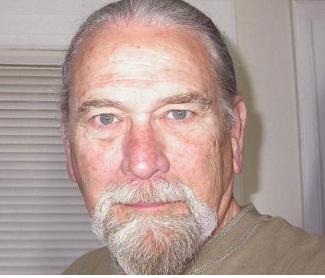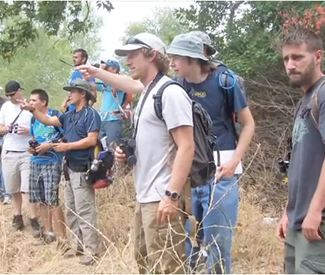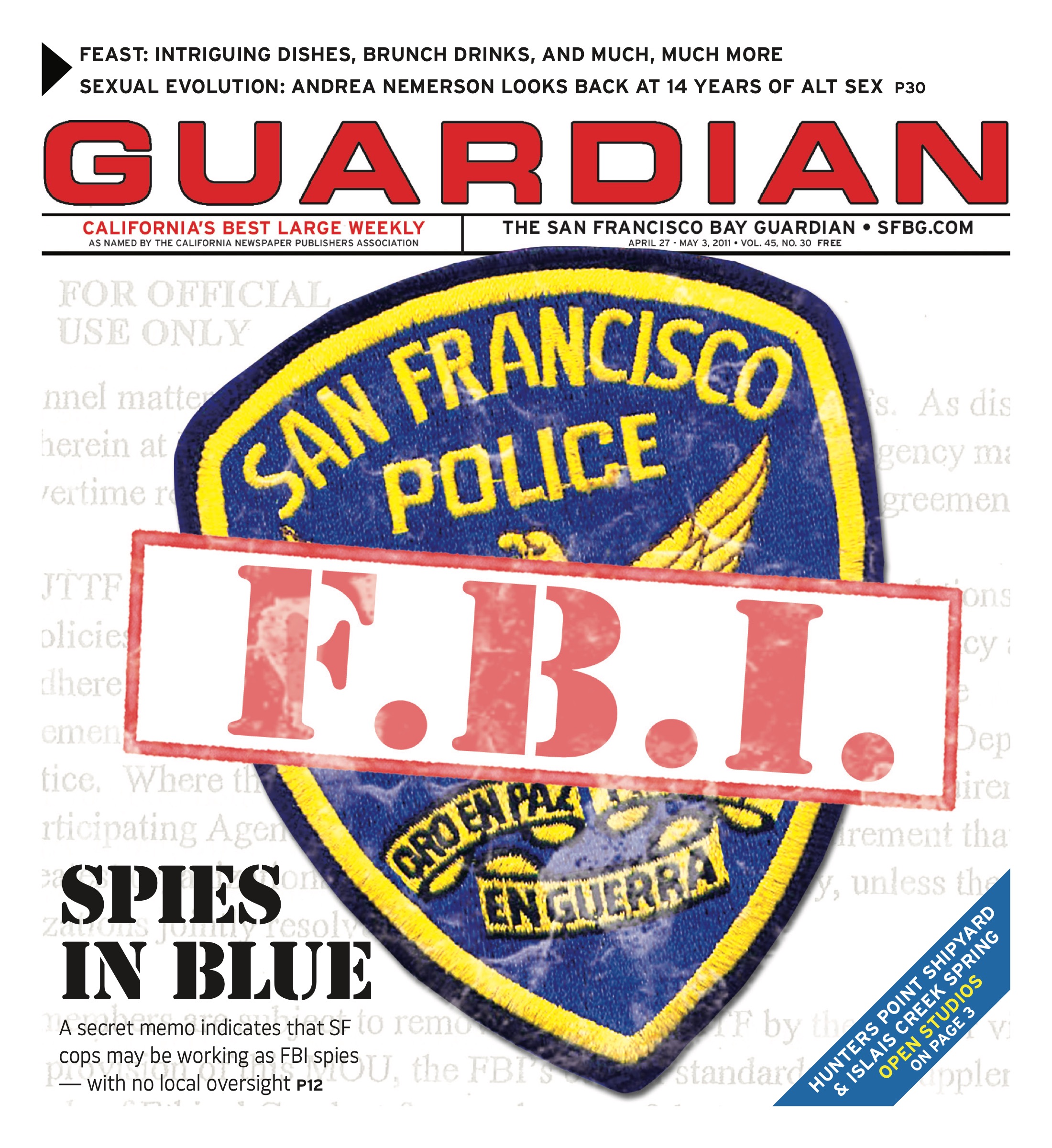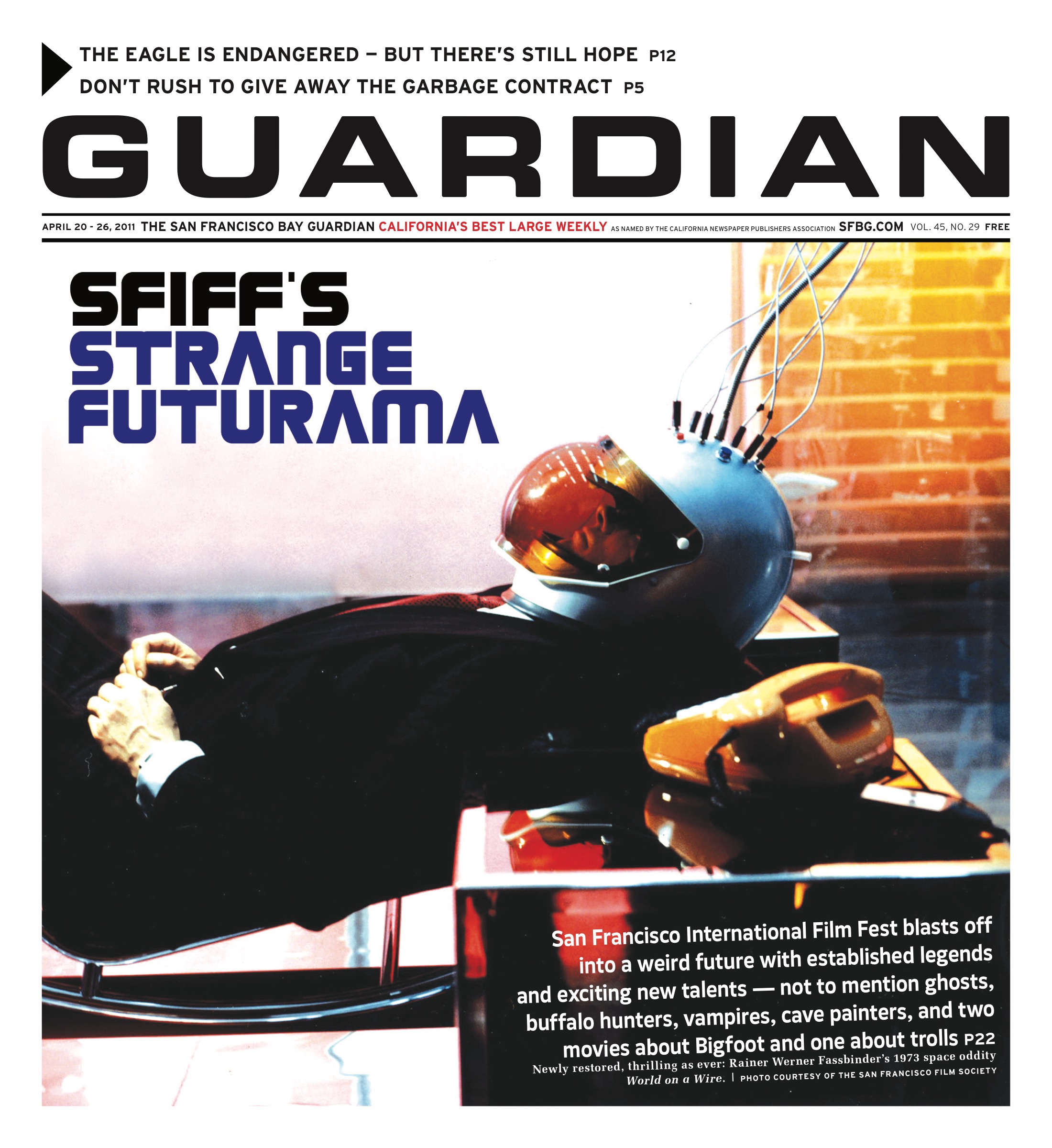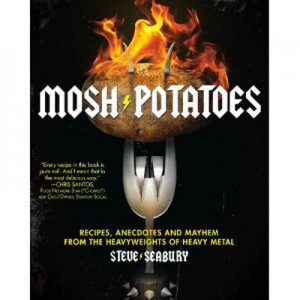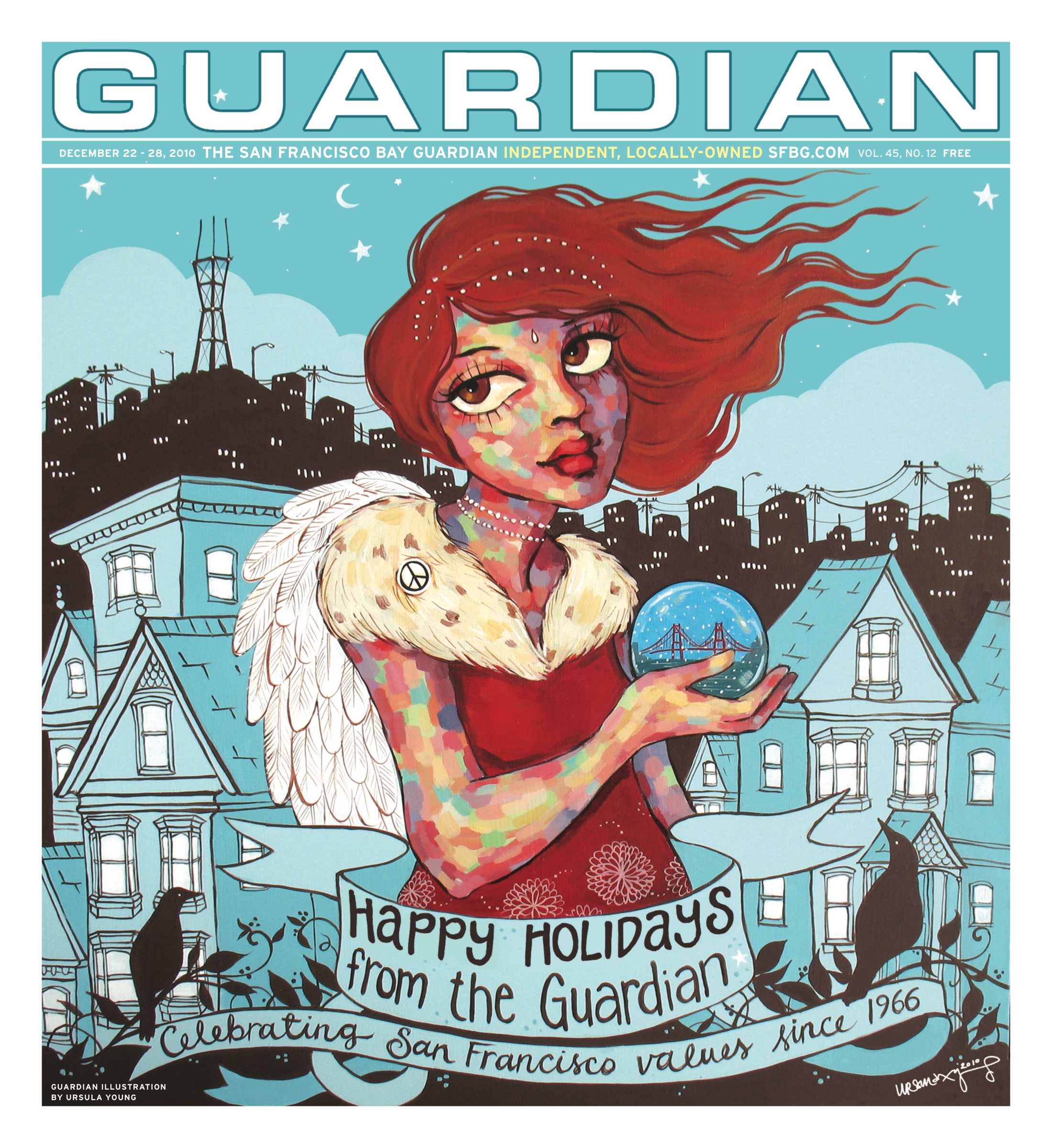WEDNESDAY 9
ROCK/BLUES/HIP-HOP
*Cradle of Filth, Nachmystium, Turisas, Daniel Lioneye Regency Ballroom. 8pm, $27.
Expendables, Hold Up, B Foundation, Mordor Slim’s. 8pm, $24.
My Revolver, Rosa Grande, Days of High Adventure Elbo Room. 9pm, $6.
Oh Sees, Sic Alps Great American Music Hall. 8pm, $16. Benefit for the Coalition on Homelessness.
7 Orange ABC, Cash Pony, Maiden Lane Rickshaw Stop. 8pm, $10.
Al B. Sure! Yoshi’s San Francisco. 8pm, $26.
Times of Grace, War Of Ages, Straight Line Stitch Bottom of the Hill. 8pm, $13.
Travis Johns-Liz Meredith Holiday Heart, Head-Head Hemlock Tavern. 9pm, $6.
JAZZ/NEW MUSIC
Cat’s Corner with Christine and Nathan Savanna Jazz. 7:30pm, $5.
Dink Dink Dink, Gaucho, Michael Abraham Amnesia. 7pm, free.
Ben Marcato and the Mondo Combo Top of the Mark. 7:30pm, $10.
“Meridian Music: Composers in Performance” Meridian Gallery, 535 Powell, SF; www.meridiangallery.org. 7:30pm, $10. “Natural History” by dancer Heloise Gold and duo Gusty Winds May Exist.
Spaceheater Revolution Café, 3248 22nd St, SF; (415) 642-0474. 8:30pm, free.
Paula West and George Mesterhazy Quartet Rrazz Room. 8pm, $35.
DANCE CLUBS
Booty Call Q-Bar, 456 Castro, SF; www.bootycallwednesdays.com. 9pm. Juanita Moore hosts this dance party, featuring DJ Robot Hustle.
Cannonball Beauty Bar. 10pm, free. Rock, indie, and nu-disco with DJ White Mike.
Hands Down! Bar on Church. 9pm, free. With DJs Claksaarb, Mykill, and guests spinning indie, electro, house, and bangers.
Jam Fresh Wednesdays Vessel, 85 Campton, SF; (415) 433-8585. 9:30pm, free. With DJs Slick D, Chris Clouse, Rich Era, Don Lynch, and more spinning top 40, mashups, hip hop, and remixes.
Mary-Go-Round Lookout, 3600 16th St, SF; (415) 431-0306. 10pm, $5. A weekly drag show with hosts Cookie Dough, Pollo Del Mar, and Suppositori Spelling.
No Room For Squares Som., 2925 16th St, SF; (415) 558-8521. 6-10pm, free. DJ Afrodite Shake spins jazz for happy hour.
Respect Wednesdays End Up. 10pm, $5. Rotating DJs Daddy Rolo, Young Fyah, Irie Dole, I-Vier, Sake One, Serg, and more spinning reggae, dancehall, roots, lovers rock, and mash ups.
Synchronize Il Pirata, 2007 16th St, SF; (415) 626-2626. 10pm, free. Psychedelic dance music with DJs Helios, Gatto Matto, Psy Lotus, Intergalactoid, and guests.
THURSDAY 10
ROCK/BLUES/HIP-HOP
Badfish: A Tribute to Sublime, My Peoples, Impalers Independent. 8pm, $20.
Jefre Cantu-Ledesma, Higuma, Jon Porras Hemlock Tavern. 9pm, $6.
Expendables, Hold Up, B Foundation, Mordor Slim’s. 8pm, $24.
*Finntroll, Ensiferum, Rotten Sound, Barren Earth DNA Lounge. 7:30pm, $25.
Kegels, Dead Panic, Bombpops, Penny Dreadfuls Thee Parkside. 9pm, $6.
Nightwatchman, Jolie Holland, Jason Webley, Ryan Harvey and Lia Rose Bottom of the Hill. 8:30pm, $12-18. Benefit for Sarah Shourd’s work to free Shane Bauer and Josh Fattal; visit www.freethehikers.org for more info.
Unauthorized Rolling Stones Biscuits and Blues. 8 and 10pm, $15.
Vir, Manatee, Wait.Think.Fast, Dandelion War Red Devil Lounge. 8pm, $6.
JAZZ/NEW MUSIC
Sheldon Forrest Savanna Jazz. 7:30pm, $5.
“Martha Wainwright Sings Piaf” Great American Music Hall. 8pm, $25.
Pete Escovedo Latin Jazz Orchestra with Sheila E. Yoshi’s San Francisco. 8 and 10pm, $20-26.
Alex Pinto Revolution Café, 3248 22nd St, SF; (415) 642-0474. 8:30pm, free.
SF Jazz Hotplate Series Amnesia. 9pm.
Stompy Jones Top of the Mark. 7:30pm, $10.
Paula West and George Mesterhazy Quartet Rrazz Room. 8pm, $40.
FOLK/WORLD/COUNTRY
Peter Himmelman, Bonfires Café Du Nord. 8pm, $18.
Jeanne and Chuck Atlas Café. 8pm, free.
Kardash Red Poppy Art House. 7pm, $15.
DANCE CLUBS
Afrolicious Elbo Room. 9:30pm, $5. DJs Pleasuremaker and Señor Oz spin Afrobeat, tropicália, electro, samba, and funk.
CakeMIX SF Wish, 1539 Folsom, SF; www.wishsf.com. 10pm, free. DJ Carey Kopp spinning funk, soul, and hip hop.
Caribbean Connection Little Baobab, 3388 19th St, SF; (415) 643-3558. 10pm, $3. DJ Stevie B and guests spin reggae, soca, zouk, reggaetón, and more.
Drop the Pressure Underground SF. 6-10pm, free. Electro, house, and datafunk highlight this weekly happy hour.
Guilty Pleasures Gestalt, 3159 16th St, SF; (415) 560-0137. 9:30pm, free. DJ TophZilla, Rob Metal, DJ Stef, and Disco-D spin punk, metal, electro-funk, and 80s.
Jivin’ Dirty Disco Butter, 354 11th St., SF; (415) 863-5964. 8pm, free. With DJs spinning disco, funk, and classics.
Kissing Booth Make-Out Room. 9pm, free. DJs Jory, Commodore 69, and more spinning indie dance, disco, 80’s, and electro.
Mestiza Bollywood Café, 3376 19th St, SF; (415) 970-0362. 10pm, free. Showcasing progressive Latin and global beats with DJ Juan Data.
Motion Sickness Vertigo, 1160 Polk, SF; (415) 674-1278. 10pm, free. Genre-bending dance party with DJs Sneaky P, Public Frenemy, and D_Ro Cyclist.
Nachtmusik Presents Knockout. 9:30pm, $4. Dark, minimal electronic with DJs Omar, Josh, and Justin.
1984 Mighty. 9pm, $2. The long-running New Wave and 80s party has a new venue, featuring video DJs Mark Andrus, Don Lynch, and celebrity guests.
Peaches Skylark, 10pm, free. With an all female DJ line up featuring Deeandroid, Lady Fingaz, That Girl, and Umami spinning hip hop.
Popscene Rickshaw Stop. 9pm, $10. Emerging artist showcase with Mona, Lesands, and DJs Aaron Axelsen and Nako.
FRIDAY 11
ROCK/BLUES/HIP-HOP
Ryan Bingham and the Dead Horses, Silent Comedy, Liam Gerner Great American Music Hall. 9pm, $21.
“Captain Beefheart Symposium” Independent. 9pm, $20-50. Conducted by Gary Lucas.
Jarrod Gorbel, Mansions, John Thatcher Hotel Utah. 9pm, $12.
Grayceon, Worm Ouroboros, Hollow Mirrors Bottom of the Hill. 10pm, $12.
Meat Beat Manifesto, Not Breathing Red Devil Lounge. 9pm, $20.
Monophonics, Cambo and the Life, DJs Effective and Ism Rickshaw Stop. 9pm, $12.
Tainted Love, Private Idaho Bimbo’s 365 Club. 9pm, $23.
Those Unknowns, Hounds and Harlots, Sydney Ducks Hemlock Tavern. 9:30pm, $6.
Tokyo Raid, Young Rapscallions, Paranoids Kimo’s. 9pm, $8.
Trombone Shorty and Orleans Ave, Los Amigos Invisibles Fillmore. 9pm, $25.
Unauthorized Rolling Stones Biscuits and Blues. 8 and 10pm, $15.
Yoya, Greenhorse Amnesia. 8pm, $5.
JAZZ/NEW MUSIC
Black Market Jazz Orchestra Top of the Mark. 9pm, $10.
Tommy Emmanuel, Sels Cuerdas: Ezequiel and Martin Etcheverry Palace of Fine Arts, 3301 Lyon, SF; www.omniconcerts.com. 8pm, $41.
Hurd Ensemble Red Poppy Art House. 8pm, $15-20.
Pete Escovedo Latin Jazz Orchestra with Sheila E. Yoshi’s San Francisco. 8 and 10pm, $24-28.
Karen Segal Savanna Jazz. 7:30pm, $8.
Paula West and George Mesterhazy Quartet Rrazz Room. 8pm, $45.
FOLK/WORLD/COUNTRY
Wiyos, Good Luck Thrift Store Outfit, Possum and Lester Slim’s. 9pm, $15. Part of the San Francisco Bluegrass and Old Time Festival.
Zoyres Revolution Café, 3248 22nd St, SF; (415) 642-0474. 9pm, free.
DANCE CLUBS
Alcoholocaust Presents Riptide Tavern. 9pm, free. With DJ What’s His Fuck and guests Micahel Beller and Brian Richards spinning old-school punk rock and other gems.
Black Valentine’s Masquerade Mighty. 10pm. Wear your anti-Valentine’s best to this party with DJs Krafty Kuts, Ill Gates, Motion Potion, and more.
Blow Up DNA Lounge. 10pm, $20. Dance party with Jeffrey Paradise, Tenderloins, and Midnight Conspiracy.
DJ Mei Lwun Medjool, 2522 Mission, SF; (415) 550-0955. 10:30pm, $10.
Fo’ Sho! Fridays Madrone Art Bar. 10pm, $5. DJs Kung Fu Chris and Makossa spin rare grooves, soul, funk, and hip-hop classics.
Fubar Fridays Butter, 354 11th St., SF; (415) 863-5964. 6pm, $5. With DJs spinning retro mashup remixes.
Good Life Fridays Apartment 24, 440 Broadway, SF; (415) 989-3434. 10pm, $10. With DJ Brian spinning hip hop, mashups, and top 40.
Heartical Roots Bollywood Café. 9pm, $5. Recession friendly reggae.
Hot Chocolate Milk. 9pm, $5. With DJs Big Fat Frog, Chardmo, DuseRock, and more spinning old and new school funk.
Indy Slash Amnesia. 10pm. With DJ Danny Slash.
Rockabilly Fridays Jay N Bee Club, 2736 20th St, SF; (415) 824-4190. 9pm, free. With DJs Rockin’ Raul, Oakie Oran, Sergio Iglesias, and Tanoa “Samoa Boy” spinning 50s and 60s Doo Wop, Rockabilly, Bop, Jive, and more.
Smile! Knockout. 9pm, $7. Psych, soul, glam, bubblegum, and more with DJ Neil Martinson.
Some Thing Stud. 10pm, $7. VivvyAnne Forevermore, Glamamore, and DJ Down-E give you fierce drag shows and afterhours dancing.
Tim Burton Ball Café Du Nord. 8pm, $15. With Imaginary Daughter, Vernian Process, the Tiger Club, and swing lessons by Swing Goth.
Treat Em Right Elbo Room. 10pm, $5. Hip-hop, funk, and reggae with DJs Vinnie Esparza, B. Cause, and guest Roger Mas.
Vintage Orson, 508 Fourth St, SF; (415) 777-1508. 5:30-11pm, free. DJ TophOne and guest spin jazzy beats for cocktalians.
SATURDAY 12
ROCK/BLUES/HIP-HOP
Aquabats! Slim’s. 8pm, $20.
*Drunk Horse, Hot Lunch, Carlton Melton El Rio. 10pm, $8.
Gentry Bronson Band, Alice Rose, Return to Mono, Dirtybirdz Hotel Utah. 5pm, $10.
Derek Hughes Biscuits and Blues. 8 and 10pm, $20.
Karl Denson’s Tiny Universe, Chali 2na, House of Vibe + Lynx Fillmore. 9pm, $25.
Murder By Death, Builders and the Butchers, Damion Suomi and the Minor Prophets Bottom of the Hill. 10pm, $15.
Need, Nerv, Stand Fight Resist Thee Parkside. 3pm, free.
Night Horse, Electric Sister, Binges Hemlock Tavern. 9:30pm, $7.
Quick and Easy Boys Grant and Green. 9pm.
Tainted Love, This Charming Band Bimbo’s 365 Club. 9pm, $23.
Tumbledown, Tater Famine, Northern Son, Ari Shine Thee Parkside. 9pm, $8.
JAZZ/NEW MUSIC
Cottontails Revolution Café, 3248 22nd St, SF; (415) 642-0474. 9pm, free.
Carol Luckenbach Savanna Jazz. 7:30pm, $8.
Pete Escovedo Latin Jazz Orchestra with Sheila E. Yoshi’s San Francisco. 8 and 10pm, $28.
Paula West and George Mesterhazy Quartet Rrazz Room. 7 and 9:30pm, $45.
FOLK/WORLD/COUNTRY
Beth Longwell, Nicolas Kouzouyan El Rio. 6pm, free.
Ricardo Peixoto Trio Red Poppy Art House. 8pm, $20.
SF Balalaika Ensemble Seventh Avenue Performances, 1329 Seventh Ave, SF; www.sevenperforms.org. 7:30pm, $15-20.
Craig Ventresco and Meredith Axelrod Atlas Café. 4pm, free.
Bucky Walters, Whiskey Puppy, Erik Clampitt, Dirt Floor Band Café Du Nord. 8:30pm, $15. Part of the San Francisco Bluegrass and Old Time Festival.
DANCE CLUBS
Bootie SF: Valentine’s Party DNA Lounge. 9pm, $6-12. Mash-ups with Adrian and Mysterious D, Smash-Up Derby with guest singer Trixxie Carr, DJ Mykill, and Dada.
Club Gossip Cat Club. 9pm. Lots of Depeche Mode with Randy Maupin, Hollie Stevens, and more.
Cockblock Rickshaw Stop. 10pm, $7. Queer dance party with DJ Nuxx and guests.
DJ Duserock Medjool, 2522 Mission, SF; (415) 550-0955. 10:30pm, $10.
Frolic Stud. 9pm, $3-7. DJs Dragn’Fly, NeonBunny, and Ikkuma spin at this celebration of anthropomorphic costume and dance. Animal outfits encouraged.
HYP Club Eight, 1151 Folsom, SF; www.eightsf.com. 10pm, free. Gay and lesbian hip-hop party, featuring DJs spinning the newest in the top 40s hip hop and hyphy.
Little Heartbreaker’s Ball Li Po Lounge. 8pm, $5. Disco and house with Dr. Sleep, Lel Ephant, Sergio, and the L’Elephant Sound System.
Rock City Butter, 354 11th St., SF; (415) 863-5964. 6pm, $5 after 10pm. With DJs spinning party rock.
Same Sex Salsa and Swing Magnet, 4122 18th St, SF; (415) 305-8242. 7pm, free.
Smithsfits Friend Club Knockout. 9:30pm, $4. Smiths and Misfits with DJs Josh Yule and Jay Howell.
Spirit Fingers Sessions 330 Ritch. 9pm, free. With DJ Morse Code and live guest performances.
Spotlight Siberia, 314 11th St, SF; (415) 552-2100. 10pm. With DJs Slowpoke, Double Impact, and Moe1.
Tormentas Tropical Elbo Room. 10pm, $5-10. Electro-cumbia with Uproot Andy, Jubilee, and DJs Disco Shawn and Oro 11.
SUNDAY 13
ROCK/BLUES/HIP-HOP
*High on Fire Slim’s. 8pm, $18.
Ky-Mani Marley, DJ Funklor Independent. 9pm, $22.
Parkway Drive, Set Your Goals, Ghost Inside, Warriors, Grave Maker DNA Lounge. 7:30pm, $18.
Ash Reiter, Cowboy and Indian Hemlock Tavern. 9pm, $6.
Smith Westerns, Yuck, Grand Lake Bottom of the Hill. 9pm, $12.
“Voice of the Wetlands All-Stars” Great American Music Hall. 8pm, $27. With Tab Benoit, Anders Osborne, Cyril Neville, Big Chief Monk Boudreaux, and more.
JAZZ/NEW MUSIC
Bijou Martuni’s, Four Valencia, SF; (415) 241-0205. 7pm, $5. Loungey love songs.
Manny Moka Biscuits and Blues. 8 and 10pm, $20.
Pete Escovedo Latin Jazz Orchestra with Sheila E. Yoshi’s San Francisco. 5 and 7pm, $5-28.
Savanna Jazz Trio and jam session Savanna Jazz. 7:30pm, $5.
Paula West and George Mesterhazy Quartet Rrazz Room. 5pm, $40.
Faith Winthrop Bliss Bar, 4026 24th St, SF; www.blissbarsf.com. 4:30pm, $10.
FOLK/WORLD/COUNTRY
Gen-11, Revtones Thee Parkside. 2pm, free.
DANCE CLUBS
Dub Mission Elbo Room. 9pm, $6. Dub, roots, and classic dancehall with DJs Sep, Maneesh the Twister, and guest Jah Yzer.
DiscoFunk Mashups Cat Club. 10pm, free. House and 70’s music.
Gloss Sundays Trigger, 2344 Market, SF; (415) 551-CLUB. 7pm. With DJ Hawthorne spinning house, funk, soul, retro, and disco.
Honey Soundsystem Paradise Lounge. 8pm-2am. “Dance floor for dancers – sound system for lovers.” Got that?
Kick It Bar on Church. 9pm. Hip-hop with DJ Zax.
La Pachanga Blue Macaw, 2565 Mission, SF; www.thebluemacawsf.com. 6pm, $10. Salsa dance party with live Afro-Cuban salsa bands.
Religion Bar on Church. 3pm. With DJ Nikita.
Swing Out Sundays Rock-It Room. 7pm, free (dance lessons $15). DJ BeBop Burnie spins 20s through 50s swing, jive, and more.
MONDAY 14
ROCK/BLUES/HIP-HOP
Cake Fillmore. 8pm, $36.50.
Honeycomb, Chloe Makes Music, Magic Leaves Café Du Nord. 8pm, $10.
Radio Dept., Young Prisms, DJ Aaron Axelson Independent. 8pm, $15.
Smith Westerns Amoeba, 1855 Haight, SF; www.amoeba.com. 6pm, free.
JAZZ/NEW MUSIC
Lavay Smith and Her Red Hot Skillet Lickers Biscuits and Blues. 8 and 10pm, $20.
Paula West and George Mesterhazy Quartet Rrazz Room. 7pm, $65.
DANCE CLUBS
Club Neon Knockout. 9pm, $5. Seventh annual Valentine’s Day Underwear Party with DJs Jamie Jams, Aidan, and more.
Death Guild DNA Lounge. 9:30pm, $3-5. Gothic, industrial, and synthpop with Joe Radio, Decay, and Melting Girl.
Krazy Mondays Beauty Bar. 10pm, free. With DJs Ant-1, $ir-Tipp, Ruby Red I, Lo, and Gelo spinning hip hop.
The Look of Love Elbo Room. 10pm, $5-8. Soul, latin, hip-hop, and dancehall with Hot Pocket, 40 Love, and DJ Whooligan.
M.O.M. Madrone Art Bar. 6pm, free. With DJ Gordo Cabeza and guests playing all Motown every Monday.
Manic Mondays Bar on Church. 9pm. Drink 80-cent cosmos with Djs Mark Andrus and Dangerous Dan.
Network Mondays Azul Lounge, One Tillman Pl, SF; www.inhousetalent.com. 9pm, $5. Hip-hop, R&B, and spoken word open mic, plus featured performers.
Sausage Party Rosamunde Sausage Grill, 2832 Mission, SF; (415) 970-9015. 6:30-9:30pm, free. DJ Dandy Dixon spins vintage rock, R&B, global beats, funk, and disco at this happy hour sausage-shack gig.
Skylarking Skylark. 10pm, free. With resident DJs I & I Vibration, Beatnok, and Mr. Lucky and weekly guest DJs.
TUESDAY 15
ROCK/BLUES/HIP-HOP
Alcoholocaust Presents Argus Lounge. 9pm, free. With DJ Crystal Meth and DJ What’s His Fuck.
Nicole Atkins and the Black Sea, Cotton Jones, That Ghost Café Du Nord. 9pm, $15.
Boyce Avenue, Megan and Liz, Tiffany Alvord Great American Music Hall. 8pm, $18.
Cake Fillmore. 8pm, $36.50.
Gashcat Café Royale, 800 Post, SF; (415) 641-6033. 8pm, free.
Gerritt, Forked, Cribdeath Hemlock Tavern. 9pm, $5.
Glitter Wizard, Seventeen Evergreen, Naked Lights, Group Rhoda Slim’s. 8pm, $5.
Hello Monster, Resurrection Men, Pony Pony Pony! Bottom of the Hill. 9pm, $8. Chuck Johnson, Jameson Swanagon Amnesia. 9pm, $5. Symbol Six, Corruptors, Soul Trash, Off By An Inch Thee Parkside. 8pm, $6. JAZZ/NEW MUSIC Ricardo Scales Top of the Mark. 6:30pm, $5. DANCE CLUBS Brazilian Wax Elbo Room. 9pm, $7. Samba with Brazil Vox plus DJs Carioca and P-Shot. Eclectic Company Skylark, 9pm, free. DJs Tones and Jaybee spin old school hip hop, bass, dub, glitch, and electro. Extra Classic DJ Night Little Baobab, 3388 19th St, SF; www.bissapbaobab.com. 10pm. Dub, roots, rockers, and reggae from the 60s, 70s, and 80s. Share the Love Trigger, 2344 Market, SF; (415) 551-CLUB. 5pm, free. With DJ Pam Hubbuck spinning house. Womanizer Bar on Church. 9pm. With DJ Nuxx.

